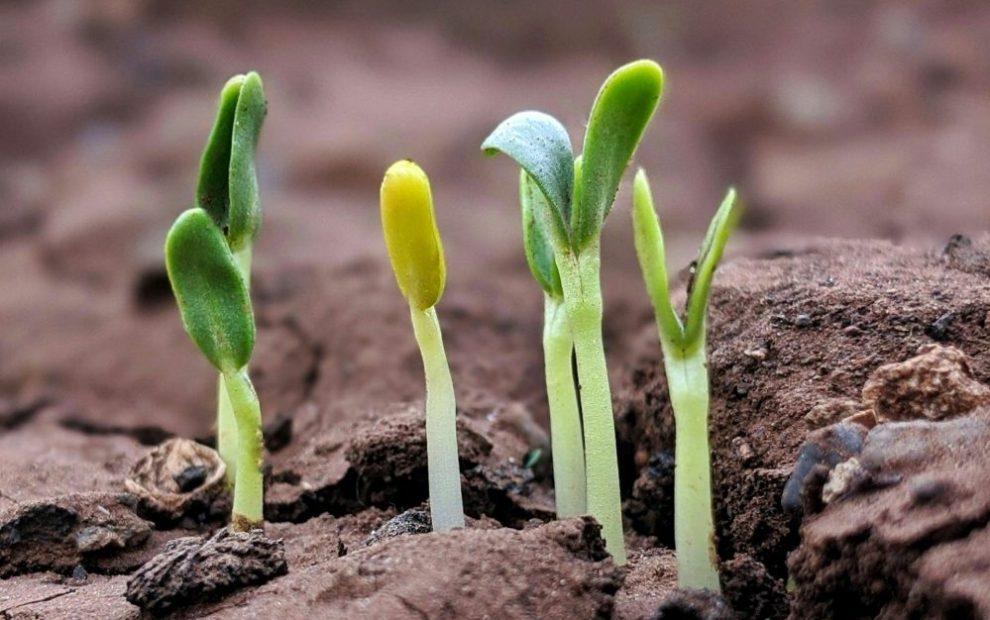When she spied one slender stalk topped by a scaly tip, my young daughter squealed and clapped gloved hands. The sprout had emerged just one inch, virtually overnight, stretching above a tangle of dry stalks, melted snow, and dead leaves at the northern edge of our family garden. This arrival had been anticipated for weeks, practically forever on the calendar of a 3-year-old.
From the time she could toddle between furrows, my first child and her sisters after her wielded colorful trowels alongside my spade and hoe as we planted and harvested everything from cucumbers to cantaloupe and green beans to grape tomatoes, often plucked, brushed against a shirt, and consumed on the spot.
As fellow nurturers, my girls learned to be alert to even the slightest sprouting. But the vegetable spotted by my oldest that late March was unique among all the leaves, fruits, and roots consumed annually from our backyard garden: The asparagus had been planted before she was born but could not be harvested until that season.
From as early as I can remember, I hurried—thinking fast, talking fast, walking fast, eating fast. Patience is a virtue, but not mine, until I was required to accept the pace of nature. From the moment I first indulged the human impulse to cultivate—caring for fellow humans or flora and fauna—I signed a contract with an immutable timeline. New life of any kind, growing inside a human body or coaxed from the earth, emerges slowly, according to a cosmic clock and without regard for even the most intense impatience. Anyone who has taught or mentored anyone, whether a child or an employee, knows that attempts to rush maturity imperils the end results: both meaningful growth and the satisfaction of witnessing it firsthand. Nature, both human and environmental, goes slow.
After a wedding and purchase of a home on nine acres, I spent years immersed in planning, plowing, and planting new beds for flowers and vegetables. The yard had once been a soybean field, still weedy and willful, but it had one overriding advantage: full sun. So I studied and strategized, investigated and invested, not only in annuals with short-lived bursts of color and fragrance but also in sturdy shrubs, flowering trees, and plots of perennials whose full beauty blossomed only after successive seasons of care and maintenance. I’d brave the weather of all months to check, coax, and coddle my crops, delighting in even the smallest developments.
Convinced my family’s roots were planted permanently on that property, after a few seasons I dedicated a four-foot-square section of the plot near our garage to asparagus. Spring of 1998 was my first as a true “earth mother,” both confident in the ability of my plants to produce in a far-off future and in my body’s capacity to knit and bear for the first time another human. Both endowments promised the security I craved and the patience I needed. From slowness came sagacity. From restraint, reward.
As toddlers, my girls heard oft-repeated tellings of the asparagus origin story, always married with their own. “Once upon a time,” I’d begin with each of them, “before you were born, I dug a trench, filled it with compost provided by our horses, and then secreted, deep in the dirt, an octopus-shaped root called a crown. I watered, tended, and abided it for four years, allowing the roots to develop over several winters so stalks would one day grow sturdy and full of possibility. Likewise, I waited nine months for your arrival, as you grew stronger and smarter inside me, unseen but already loved.”
“Sometimes we must trust nature’s clock over our own,” I told my children. The point of the planting parable every time was that “good things come to those who wait.” And because they were each a wanted, an awaited, darling daughter of God, they were good indeed.
Immersion in the natural world, whether a garden or a gorge, has provided spiritual connection for centuries. “Creation is the song of God,” wrote medieval abbess Hildegard of Bingen, also an herbalist and healer. She taught that being out of sync with the beauty and fecundity of nature is to deny the force which enlivens body and soul. She called this force viriditas, the Latin word for “greenness.” We are not above nature, but an intimate part of it. In the wonder and splendor of nature, she saw a divine underpinning that sustained not only the Earth but also the cosmos.
Gardening alongside my daughters offered all of us a pace unchanged and eternal, natural and sublime. We resisted culture’s push to make children’s calendars as cluttered as those of adults, opting instead for Saturday afternoons fashioning crowns of clover for our hair, walking in the woods behind our home, and swinging on a hammock with barn cats on our laps or a grazing horse alongside.
So often has the pace of modernity taxed the ability of humans to keep up that history is full of “slowdown” reform movements and cultural shifts, both spiritual and secular. Buddhist monastics retreated to the desert to pursue a life of “slow thought”—meditation—over 2500 years ago. In the fourth century, Catholic monasteries made space for prayer, silence, and reflection seven times a day by praying the Divine Office. My back-to-earth, grow-my-own asparagus impulses emerged from the Slow Food Movement of late 1980s, which spawned slow movements in almost every aspect of culture, from cinema to city life, gaming to gardening, and fashion to faith. It is now sometimes known as “new monasticism.”
First-time visitors to present-day monasteries are sometimes surprised by how slowly monks chant and how often they pause between readings and prayers. The silences are intentional, of course, to allow reflection. Slowness allows “discernment,” the ability to think clearly, set goals, and determine the best way forward without rushing. St. Ignatius of Loyola taught his followers to “never make a decision in desolation,” that is, any time when anxiety and pain make objective perspective unlikely. His Daily Examen guides self-reflection at midday or evening or both. The steps include first, realizing a holy presence; then, expressing gratitude; next, reviewing the day’s events with that presence’s help; then finally, admitting shortcomings and asking forgiveness—until looking forward to the next day considering all that was learned. Fruits of this method are achieved not by analysis but by release of expectations. In a place of surrender and acceptance, better decisions to act—or permission to not act at all—arise.
Unfortunately for me, before learning the importance of surrender from 12-step groups for families of alcoholics, my desolation increased as my daughters grew older. By the time they were middle schoolers, it became impossible to dispatch them to bed before their father’s pints, peevishness and passive-aggressive pitch-battles began. I turned to structure and standards to shield them instead. With charts and schedules, I planned all aspects of their lives, from media use to music practice, from schoolwork to barn work, from food to fun. My rearing and our relationships grew as hard-edged and thorny as the honey locust trees growing in our backwoods. Only years later did I understand their anger when I dropped all of that control and divorced their abusive father.
To assure perennial plentitude of nutritious harvest for years to come, I left young asparagus plants to flourish until they, willowy cousins of the houseplant known as asparagus fern, feathered. Even after maturity, I refrained from harvesting every spear, leaving the thinnest and thickest behind to recharge rhizomes hiding in the dirt. I never expected to apply the same methods to parenting still-young teenagers.
In healthy families, “unparenting” happens organically, timed in accordance with maturation. But in families marred by addiction, divorce, or mental illness, children are often wrested from parental care before either party in the relationship is ready. I was forced to leave my children to grow on their own. That was a harvest hard to swallow.
When I ended my season as a caretaker of an addict, I also quit being an over-nurturing parent. During a protracted divorce and aftermath, I realized that insisting my love be returned by my daughters would imperil growth of any enduring future relationship. Although we lived in the same city, three consecutive Mother’s Days passed without celebration, and other holidays and birthdays were sometimes acknowledged only by mailed greeting cards or text message exchanges. I waited. I slowed, rarely communicating unless and until they initiated a conversation. Before indulging any deep-seated instinct to advise or attend, parent or plan around my progeny, I did nothing instead. As Dennis Wholey writes in his book about alcoholism, The Courage to Change, “Waiting is an art…waiting achieves things. Waiting can be very, very powerful. Time is a valuable thing. If you can wait two years, you can sometimes achieve something that you could not achieve today, however hard you worked.”
In the meantime, I cultivated goals all my own and the confidence to achieve them without guilt. I learned to think again. Just as I allowed feathery asparagus ferns to take over my garden each June, wither each September, then come back stronger than ever the following March, I trusted that the divine rhythm of rebirth would someday yield a more perfect love, one shared with my daughters and then multiplied a hundredfold.
Image: Unsplash/Chetan Kolte














Add comment